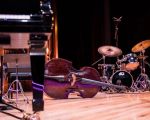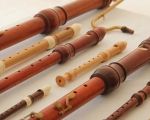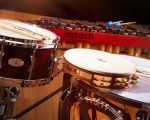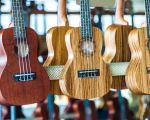Introduction: The Rich World of Middle Eastern Music
Middle Eastern music is known for its deep cultural significance and its ability to transport listeners to distant lands through its intricate rhythms and melodious tones. One of the key components of Middle Eastern music is its unique and diverse instruments. As someone who has always been captivated by the intricate and expressive sounds of this region, I was curious to dive deeper into the instruments that help create this mesmerizing music. What struck me the most was the incredible range of traditional instruments used in Middle Eastern music, each with its own history and distinct role in performances.
1. The Oud: The Heart of Middle Eastern Music
The oud is often considered the king of Middle Eastern instruments. A stringed instrument similar to the lute, the oud is the central feature in many traditional Middle Eastern music ensembles. I had the privilege of seeing a talented musician play the oud at a local cultural festival, and I was immediately struck by its rich, deep sound. The oud's round body and pear-shaped design help amplify its warm, resonant tone, which is key to creating the soulful melodies that Middle Eastern music is famous for.
The oud has a history that spans over thousands of years, and its influence can be seen in musical traditions from Spain to India. Its role in Middle Eastern music is crucial—it provides both melody and harmony, often carrying the main theme of the piece while accompanying other instruments. When I learned that the oud lacks frets, allowing for a greater range of microtonal notes, it all made sense. The ability to express a wider range of emotions is what gives Middle Eastern music its unique sound, and the oud is the instrument that facilitates this depth of expression.
2. The Darbuka: A Drum of Distinction
The darbuka, also known as the goblet drum, is another essential instrument in Middle Eastern music. Its distinct shape—a goblet-like body with a wide, shallow top—creates a sharp, percussive sound. The darbuka is often used in folk music and dance performances, where its rapid rhythms are essential for creating the energetic and hypnotic beats that drive the music forward. I had the chance to try playing the darbuka during a drum circle session, and I quickly realized how the drum's rich, rhythmic tones are perfect for adding a layer of excitement and movement to the music.
Whether in intimate settings or large performances, the darbuka’s versatility makes it a go-to instrument for many musicians. In fact, many famous Middle Eastern drummers are known for their skillful darbuka playing, which is an art form in itself. Its ability to create complex rhythms with just a few hand strikes is truly fascinating. The interplay between the darbuka and the oud in an ensemble is a classic example of the rich, textured sound of Middle Eastern music.
3. The Qanun: A Heavenly String Instrument
The qanun, a large, zither-like instrument, adds a layer of ethereal beauty to Middle Eastern music. Resembling a harp but played horizontally, the qanun is a string instrument that creates a bright, melodic sound. I was lucky enough to attend a concert where a skilled qanun player performed a piece that left the audience in awe. Its bright tones filled the room, adding a layer of sophistication and complexity to the music.
What makes the qanun especially unique is its tuning system, which is based on microtonal intervals, allowing for the subtle nuances that are characteristic of Middle Eastern music. The qanun is often used to accompany vocal performances or to add harmonic richness to instrumental ensembles. Its use of plucked strings creates a delicate, shimmering sound that is a perfect complement to the deep resonance of the oud or the lively beat of the darbuka.
4. The Nay: The Soulful Flute
The nay is a traditional Middle Eastern flute that has been used in the region for centuries. Made from a simple cane, the nay produces a haunting, breathy sound that adds a unique texture to Middle Eastern music. I remember listening to a solo nay performance and feeling transported to another world—the sound of the flute was both meditative and expressive, evoking deep emotions and creating a sense of tranquility. The nay is often used in Sufi music, where its mournful tone is perfect for creating a contemplative, spiritual atmosphere.
The nay’s sound is achieved by blowing across the end of the cane, much like blowing into a bottle, and its pitch can be altered through finger placements on its holes. This simplicity allows for a wide range of expression, making it an indispensable instrument in Middle Eastern music. Whether in religious ceremonies or concert performances, the nay's beautiful, soulful tones provide a compelling contrast to the sharper, more percussive sounds of other instruments.
5. The Violin: A Western Instrument with an Eastern Twist
The violin, although a Western instrument, has found a prominent place in Middle Eastern music. What makes it distinctive in this musical tradition is the way it is played—often without the use of a bow, or with different techniques that allow for more flexibility in pitch. The violin can be used to create the expressive, sliding notes that are common in Middle Eastern music, blending seamlessly with the other instruments. I’ve heard violinists incorporate both Western and Eastern techniques to create a fusion of sounds that’s truly unique to the region.
In Middle Eastern ensembles, the violin plays a vital role in both melodic and harmonic structures, complementing the oud and qanun while adding a touch of refinement. The violin’s capacity for delicate, sweeping melodies is a perfect fit for the intricate nature of the region’s music. While the violin may have originated in the West, its adaptation to Middle Eastern music is a testament to the region’s ability to embrace and transform foreign elements into something entirely their own.
Conclusion: The Beauty of Middle Eastern Instruments
As I’ve learned more about the rich and diverse instruments used in Middle Eastern music, I’ve developed a deep appreciation for how each instrument contributes to the overall sound and feel of the music. From the resonant tones of the oud to the rhythmic beats of the darbuka, and the haunting melodies of the nay, every instrument plays a unique role in creating the vibrant and evocative music of the region. Exploring these instruments has opened my ears to the incredible range of sounds that make Middle Eastern music so captivating. Whether you’re a musician or simply a listener, understanding these instruments will deepen your connection to the music and culture of the Middle East.








